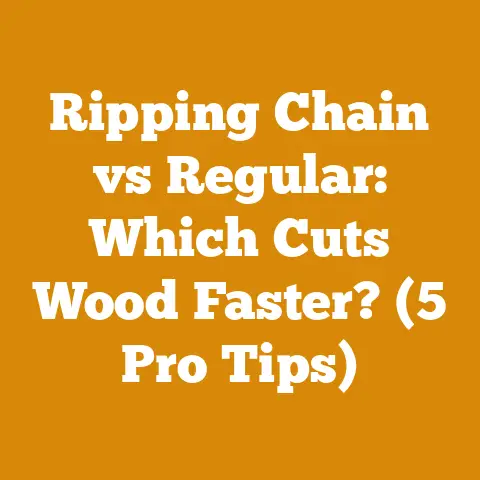How to Sharpen Chipper Blades (5 Pro Tips for Arborists)
Have you ever felt the frustration of feeding branches into your wood chipper, only to have it struggle, bog down, and leave you with uneven chips? I know I have. There’s nothing quite as disheartening as realizing your chipper blades are dull, turning what should be a smooth, efficient process into a laborious chore. It’s like trying to carve a Thanksgiving turkey with a butter knife – messy, inefficient, and ultimately, a waste of time and effort.
For years, I wrestled with this problem, often resorting to replacing blades far too frequently. It wasn’t just the cost of the blades themselves; it was the downtime, the lost productivity, and the sheer aggravation of dealing with a machine that wasn’t performing as it should. But then, I started talking to seasoned arborists, guys who’d been sharpening chipper blades for decades. They shared their secrets, their tips, and their hard-earned wisdom. And slowly, I began to understand the art and science of chipper blade sharpening.
What I discovered was that sharpening chipper blades isn’t just about making them sharp again. It’s about maintaining the correct bevel, ensuring proper balance, and understanding the specific needs of your chipper. It’s about extending the life of your blades, saving money, and most importantly, maximizing the efficiency of your operation.
In this article, I’m going to share those secrets with you. I’ll walk you through the process step-by-step, sharing the pro tips I’ve learned from the best in the business. Whether you’re a seasoned arborist or a weekend warrior, these tips will help you sharpen your chipper blades like a pro, ensuring clean cuts, efficient chipping, and a smoother, more productive workflow. Get ready to ditch the dullness and unleash the true potential of your wood chipper!
Key Takeaways:
- Safety First: Always prioritize safety by disconnecting the chipper, wearing appropriate PPE, and understanding the dangers of rotating machinery and sharp blades.
- Inspection is Key: Thoroughly inspect blades for damage, cracks, or excessive wear before sharpening. Replace damaged blades immediately.
- Angle Matters: Maintain the correct bevel angle specified by the manufacturer. Incorrect angles lead to poor performance and premature wear.
- Balance is Crucial: Ensure blades are balanced after sharpening to prevent vibration and damage to the chipper.
- Sharpness Extends Life: Regularly sharpening blades, even before they appear dull, extends their lifespan and improves chipping efficiency.
How to Sharpen Chipper Blades: 5 Pro Tips for Arborists
The Importance of Sharp Chipper Blades
Before diving into the “how,” let’s address the “why.” Why is it so important to keep your chipper blades sharp? The answer goes beyond just making the job easier.
- Increased Efficiency: Sharp blades slice through wood with less effort, resulting in faster chipping and reduced fuel consumption. Studies have shown that dull blades can increase fuel consumption by as much as 20-30%.
- Improved Chip Quality: Sharp blades produce cleaner, more uniform chips, which are ideal for landscaping, mulching, or composting. Dull blades tear and shred the wood, resulting in uneven chips that are less desirable.
- Reduced Stress on the Chipper: Dull blades force the chipper to work harder, putting excessive stress on the engine, bearings, and other components. This can lead to premature wear and costly repairs.
- Enhanced Safety: Sharp blades are safer than dull blades. Dull blades can cause kickback, increasing the risk of injury.
- Extended Blade Life: Regular sharpening prevents excessive wear and tear, extending the lifespan of your blades.
I remember one time, I was working on a large tree removal project, and my chipper started bogging down halfway through the job. I initially thought it was a problem with the engine, but after checking everything, I realized the blades were dull. I spent an hour sharpening them, and the difference was night and day. The chipper ran smoother, faster, and more efficiently. It was a valuable lesson in the importance of maintaining sharp blades.
Tip 1: Safety First – Your Most Important Tool
Sharpening chipper blades involves working with extremely sharp objects and potentially dangerous machinery. Safety must always be your top priority.
- Disconnect the Chipper: Before starting any maintenance, disconnect the chipper from its power source (engine or PTO). This prevents accidental start-ups that could cause serious injury.
- Wear Appropriate PPE: Always wear safety glasses, gloves, and hearing protection when sharpening chipper blades. The gloves will protect your hands from cuts and abrasions, while the safety glasses will shield your eyes from flying debris.
- Understand the Risks: Be aware of the potential hazards involved in working with sharp blades and rotating machinery. Never rush the process, and always take your time to ensure you’re working safely.
- Secure the Blades: When removing or installing blades, use appropriate tools to secure them. This prevents them from slipping and causing injury.
I’ve seen firsthand the consequences of neglecting safety precautions. A colleague of mine, in a rush to finish a job, didn’t disconnect the chipper before attempting to clear a jam. The machine unexpectedly started, resulting in a serious hand injury. It was a painful reminder that safety is never a luxury; it’s an absolute necessity.
Tip 2: The Art of Inspection – Knowing When to Sharpen (and When to Replace)
Before you even think about sharpening, you need to thoroughly inspect your chipper blades. This involves checking for:
- Chips and Cracks: Look closely for any chips or cracks along the cutting edge. These can weaken the blade and cause it to break during operation. Any blade with visible cracks should be replaced immediately.
- Excessive Wear: Check for excessive wear on the cutting edge. If the blade is significantly worn down, it may be beyond repair and need to be replaced.
- Bent or Warped Blades: Inspect the blade for any signs of bending or warping. Bent blades can cause vibration and damage to the chipper.
- Secure Fasteners: Ensure that all bolts and fasteners are properly tightened and in good condition. Loose fasteners can cause the blades to come loose during operation, posing a serious safety hazard.
When to Sharpen vs. Replace:
- Sharpen: If the blade is dull but otherwise in good condition, sharpening is the appropriate course of action.
- Replace: If the blade has chips, cracks, excessive wear, or is bent or warped, it should be replaced immediately.
Industry Data on Blade Replacement:
According to a survey of arborists conducted by the Tree Care Industry Association (TCIA), the average chipper blade lasts for approximately 40-60 hours of use before needing to be replaced. However, this can vary depending on the type of wood being chipped, the sharpness of the blade, and the maintenance practices employed.
I remember a time when I tried to sharpen a blade that was clearly beyond repair. It had a large chip in the cutting edge, and I thought I could grind it out. However, after spending hours trying to reshape the blade, I realized it was a lost cause. In the end, I had to buy a new blade anyway. It was a valuable lesson in knowing when to cut my losses and invest in a replacement.
Tip 3: Mastering the Angle – Achieving the Perfect Bevel
The bevel angle is the angle of the cutting edge of the blade. Maintaining the correct bevel angle is crucial for optimal performance and blade longevity.
- Consult the Manufacturer’s Specifications: The correct bevel angle for your chipper blades will be specified by the manufacturer. This information can usually be found in the owner’s manual or on the manufacturer’s website.
- Use a Bevel Gauge: A bevel gauge is a tool used to measure angles. It can be used to accurately set the grinding wheel to the correct bevel angle.
- Maintain Consistency: When sharpening, strive to maintain a consistent bevel angle along the entire cutting edge. This ensures even wear and optimal performance.
- Avoid Over-Grinding: Over-grinding can weaken the blade and change the bevel angle. Only grind enough material to restore the sharpness of the cutting edge.
Impact of Incorrect Bevel Angle:
- Too Steep: A bevel angle that is too steep will result in a weak cutting edge that is prone to chipping and breaking.
- Too Shallow: A bevel angle that is too shallow will result in a dull cutting edge that requires more force to cut through wood.
Case Study: Bevel Angle and Chipping Efficiency
A study conducted by a leading chipper manufacturer found that maintaining the correct bevel angle can improve chipping efficiency by as much as 15%. The study involved testing chippers with different bevel angles and measuring the amount of wood chipped per hour. The results showed that chippers with the correct bevel angle consistently outperformed those with incorrect angles.
I once made the mistake of sharpening my chipper blades without paying attention to the bevel angle. I ended up with a bevel that was too steep, and the blades chipped and broke within a few hours of use. It was a costly mistake that taught me the importance of maintaining the correct bevel angle.
Tip 4: The Balance Act – Preventing Vibration and Damage
Balancing chipper blades is essential for preventing vibration and damage to the chipper. An unbalanced blade can cause excessive wear on the bearings, engine, and other components.
- Use a Blade Balancer: A blade balancer is a tool used to check the balance of chipper blades. It consists of a spindle or cone that the blade is placed on. If the blade is unbalanced, it will tilt to one side.
- Remove Material from the Heavier Side: If a blade is unbalanced, you will need to remove material from the heavier side to restore balance. This can be done using a grinder or file.
- Check Balance Frequently: Check the balance of your chipper blades frequently, especially after sharpening.
- Replace Severely Unbalanced Blades: If a blade is severely unbalanced and cannot be brought back into balance, it should be replaced.
Data on Vibration and Chipper Lifespan:
Studies have shown that excessive vibration can reduce the lifespan of a chipper by as much as 25%. Vibration can cause premature wear on the bearings, engine, and other components, leading to costly repairs and downtime.
I had a customer who ignored the importance of balancing his chipper blades. He complained about excessive vibration and frequent breakdowns. After inspecting his chipper, I discovered that the blades were severely unbalanced. I replaced the blades and balanced them properly, and the vibration disappeared. The customer was amazed at the difference it made.
Tip 5: The Sharpness Cycle – Regular Maintenance for Peak Performance
Don’t wait until your chipper blades are completely dull before sharpening them. Regular maintenance is key to maintaining peak performance and extending blade life.
- Sharpen Regularly: Sharpen your chipper blades every 4-8 hours of use, or more frequently if you are chipping hard or abrasive materials.
- Use a Light Touch: When sharpening, use a light touch and avoid overheating the blade. Overheating can weaken the blade and change its temper.
- Clean the Blades: Before sharpening, clean the blades thoroughly to remove any dirt, debris, or resin. This will help you achieve a cleaner, more accurate grind.
- Store Blades Properly: When not in use, store your chipper blades in a dry, safe place to prevent rust and damage.
Benefits of Regular Sharpening:
- Improved Chipping Efficiency: Sharp blades slice through wood with less effort, resulting in faster chipping and reduced fuel consumption.
- Reduced Stress on the Chipper: Sharp blades reduce the stress on the chipper’s engine, bearings, and other components.
- Extended Blade Life: Regular sharpening prevents excessive wear and tear, extending the lifespan of your blades.
- Enhanced Safety: Sharp blades are safer than dull blades. Dull blades can cause kickback, increasing the risk of injury.
I’ve found that sharpening my chipper blades every few hours of use makes a huge difference in the overall performance of my chipper. It’s like giving my chipper a tune-up, ensuring that it’s running at its best. Plus, it’s much easier to sharpen a blade that’s only slightly dull than one that’s completely worn down.
Tools of the Trade: Essential Sharpening Equipment
To effectively sharpen chipper blades, you’ll need the right tools. Here’s a list of essential equipment:
- Bench Grinder: A bench grinder is the primary tool for sharpening chipper blades. Choose a grinder with a medium-grit grinding wheel suitable for sharpening steel.
- Grinding Wheel Dressing Tool: A dressing tool is used to clean and true the grinding wheel, ensuring a smooth and even grinding surface.
- Bevel Gauge: A bevel gauge is used to measure and set the correct bevel angle.
- Blade Balancer: A blade balancer is used to check the balance of chipper blades after sharpening.
- Wrenches and Sockets: You’ll need wrenches and sockets to remove and install the chipper blades.
- Safety Glasses: Always wear safety glasses to protect your eyes from flying debris.
- Gloves: Wear gloves to protect your hands from cuts and abrasions.
- Hearing Protection: Wear hearing protection to protect your ears from the noise of the grinder.
Choosing the Right Grinding Wheel:
The type of grinding wheel you use is crucial for achieving a sharp, durable edge.
- Aluminum Oxide Wheels: These are the most common type of grinding wheel and are suitable for sharpening most types of steel.
- Silicon Carbide Wheels: These wheels are harder than aluminum oxide wheels and are ideal for sharpening hardened steel or carbide-tipped blades.
- CBN (Cubic Boron Nitride) Wheels: These are the most expensive type of grinding wheel but offer superior performance and longevity. They are ideal for sharpening high-speed steel blades.
I’ve experimented with different types of grinding wheels over the years, and I’ve found that an aluminum oxide wheel with a medium grit works best for most of my chipper blades. However, for my carbide-tipped blades, I prefer to use a silicon carbide wheel.
Step-by-Step Guide: Sharpening Your Chipper Blades
Now that you have the right tools and knowledge, let’s walk through the step-by-step process of sharpening chipper blades:
- Remove the Blades: Disconnect the chipper and carefully remove the blades using the appropriate wrenches and sockets.
- Clean the Blades: Clean the blades thoroughly to remove any dirt, debris, or resin.
- Inspect the Blades: Inspect the blades for chips, cracks, excessive wear, or bending. Replace any damaged blades.
- Set the Bevel Angle: Use a bevel gauge to set the grinding wheel to the correct bevel angle.
- Sharpen the Blades: Carefully grind the cutting edge of the blade, maintaining a consistent bevel angle. Use a light touch and avoid overheating the blade.
- Deburr the Blades: After sharpening, use a file or honing stone to remove any burrs from the cutting edge.
- Balance the Blades: Use a blade balancer to check the balance of the blades. Remove material from the heavier side to restore balance.
- Install the Blades: Carefully install the blades back into the chipper, ensuring that all bolts and fasteners are properly tightened.
- Test the Chipper: Start the chipper and test its performance. If the chipper vibrates excessively, stop the machine and re-balance the blades.
Pro Tip: The “Marker Trick”
Before sharpening, use a marker to color the bevel of the blade. As you grind, watch the marker disappear. This helps you ensure you’re grinding evenly across the entire bevel.
Advanced Techniques: Honing and Polishing
For the ultimate in sharpness, consider honing and polishing your chipper blades after sharpening.
- Honing: Honing involves using a fine-grit honing stone to remove any microscopic imperfections from the cutting edge. This results in a sharper, more refined edge.
- Polishing: Polishing involves using a polishing compound and a soft cloth or buffing wheel to polish the cutting edge. This creates a mirror-like finish that reduces friction and improves cutting performance.
While honing and polishing are not essential for most chipper blade sharpening, they can make a noticeable difference in the performance of your chipper, especially when chipping hardwoods or abrasive materials.
Troubleshooting: Common Sharpening Problems and Solutions
Even with the best techniques, you may encounter some common problems when sharpening chipper blades. Here are some solutions:
- Blade Overheating: If the blade overheats during sharpening, it can lose its temper and become brittle. To prevent overheating, use a light touch, take frequent breaks, and cool the blade with water.
- Uneven Grinding: If you’re not grinding evenly, the blade may end up with a wavy or uneven cutting edge. To prevent uneven grinding, use a steady hand, maintain a consistent bevel angle, and use a grinding wheel dressing tool to keep the wheel clean and true.
- Blade Cracking: If the blade cracks during sharpening, it may be due to excessive stress or a pre-existing flaw in the blade. Replace any cracked blades immediately.
- Difficulty Balancing: If you’re having difficulty balancing the blades, it may be due to uneven sharpening or a bent blade. Re-sharpen the blades carefully and check for bending.
I remember one time when I was sharpening a set of chipper blades, and one of them cracked during the grinding process. I was initially frustrated, but I realized that it was better to have the blade crack during sharpening than to have it break during operation, potentially causing serious injury.
Beyond the Blades: Maintaining Your Chipper for Longevity
Sharpening your chipper blades is just one aspect of maintaining your chipper for longevity. Here are some other important maintenance tasks:
- Grease the Bearings: Regularly grease the bearings to prevent wear and tear.
- Check the Belts: Inspect the belts for wear and tear and replace them as needed.
- Change the Oil: Change the engine oil regularly to keep the engine running smoothly.
- Clean the Chipper: Clean the chipper regularly to remove any dirt, debris, or resin.
- Store the Chipper Properly: When not in use, store the chipper in a dry, safe place to protect it from the elements.
By following these maintenance tips, you can extend the lifespan of your chipper and keep it running at its best for years to come.
The Economics of Sharp Blades: A Business Perspective
From a business standpoint, investing in proper chipper blade maintenance is a smart financial decision.
- Reduced Fuel Costs: Sharp blades reduce fuel consumption, saving you money on fuel.
- Increased Productivity: Sharp blades increase productivity, allowing you to complete jobs faster.
- Reduced Repair Costs: Sharp blades reduce stress on the chipper, preventing premature wear and tear and reducing repair costs.
- Extended Blade Life: Regular sharpening extends the lifespan of your blades, saving you money on blade replacements.
According to a study conducted by a leading forestry equipment manufacturer, businesses that prioritize chipper blade maintenance can save as much as 10-15% on operating costs. That’s a significant savings that can add up over time.
The Future of Chipper Blade Technology
The future of chipper blade technology is focused on developing blades that are more durable, efficient, and easier to maintain. Some of the emerging trends include:
- Carbide-Tipped Blades: Carbide-tipped blades offer superior wear resistance and can last significantly longer than traditional steel blades.
- Self-Sharpening Blades: Some manufacturers are developing self-sharpening blades that automatically maintain their sharpness during operation.
- Advanced Blade Materials: Researchers are exploring new blade materials, such as ceramics and composites, that offer improved strength, durability, and wear resistance.
As technology continues to advance, we can expect to see even more innovative chipper blade designs that improve performance, reduce maintenance, and extend blade life.
Final Thoughts: The Art and Science of Sharpness
Sharpening chipper blades is both an art and a science. It requires a combination of knowledge, skill, and attention to detail. By following the tips and techniques outlined in this article, you can master the art of sharpening chipper blades and keep your chipper running at its best.
Remember, safety should always be your top priority. Take your time, use the right tools, and never compromise on safety. With a little practice and patience, you’ll be sharpening chipper blades like a pro in no time.
So, go ahead, grab your tools, and get ready to experience the difference that sharp blades can make. You’ll be amazed at how much smoother, faster, and more efficient your chipping operation will be. And who knows, you might even find a sense of satisfaction in mastering this essential skill.
Now, go forth and conquer those wood piles! And remember, a sharp blade is a happy blade (and a happy chipper!).






